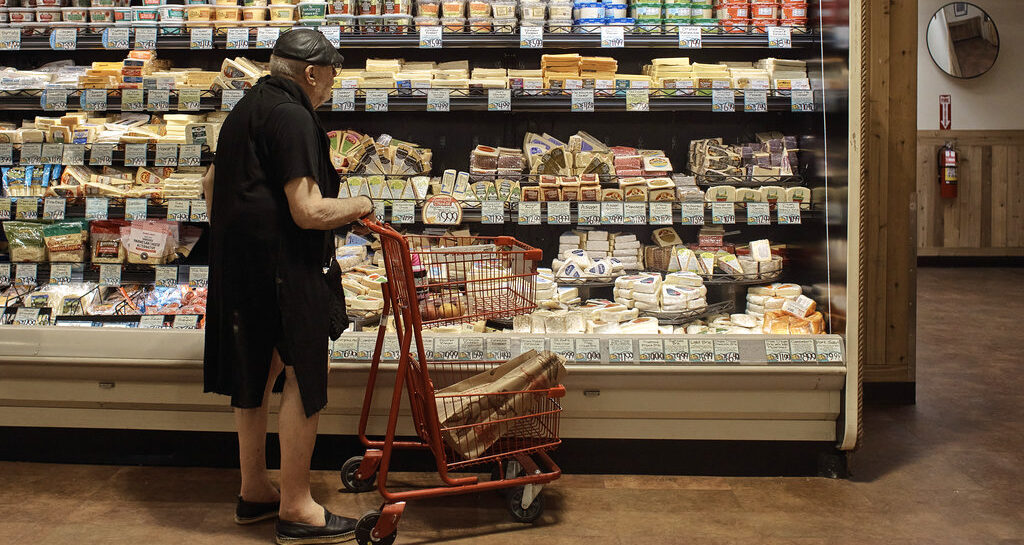[ad_1]
Inflation eased last month as energy prices tumbled, raising hopes that the surging costs of everything from gasoline to food may have peaked.
According to a Commerce Department report Friday that is closely watched by the Federal Reserve, consumer prices rose 6.3% in July from a year earlier after posting an annual increase of 6.8% in June, the biggest jump since 1982. Energy prices made the difference in July: They dropped last month after surging in June.
Yet on the same day at the Federal Reserve’s annual economic symposium in Jackson Hole, Chair Jerome Powell delivered a stark message: The Fed will likely impose more large interest rate hikes in coming months and is resolutely focused on taming inflation.
There was hope that the Fed might signal a moderation in rate increases if inflation were to show further signs of easing.
So-called core inflation, which excludes volatile food and energy prices, rose 4.6% last month from a year earlier after rising 4.8% in June. The drop — along with a reduction in the Labor Department’s consumer price index last month — suggests that inflationary pressures may be easing.
On a monthly basis, consumer prices actually fell 0.1% from June to July; core inflation blipped up 0.1%, the Commerce Department reported.
And the Fed appears ready to continue efforts to ensure prices are moving in the right direction.
Inflation started rising sharply in the spring of 2021 as the economy rebounded with surprising speed from the short but devastating coronavirus recession a year earlier. Surging customer orders overwhelmed factories, ports and freight yards, leading to delays, shortages and higher prices. Inflation is a worldwide problem, especially since the Russian invasion of Ukraine drove up global food and energy prices.
On Friday, regulators in the U.K. said that residents will see an 80% increase in their annual household energy bills.
In the United States, the Commerce Department’s personal consumption expenditures (PCE) index is less well known than the Labor Department’s consumer price index (CPI).
But the Fed prefers the PCE index as a gauge of inflationary pressures, partly because the Commerce index attempts to measure how consumers adjust to rising prices by, for example, substituting cheaper store brands for pricier name brands.
There is evidence just in the last several months that that is taking place at numerous levels.
CPI has been showing higher inflation than PCE; Last month, for instance, CPI was running at an 8.5% annual pace after hitting a four-decade high 9.1% in June. One reason: The Labor Department’s index gives more weight to rents, which have soared this year.
The Commerce Department also reported Friday that Americans’ after-tax personal income rose 0.3% from June to July after adjusting for inflation; it has fallen in June. Consumer spending rose 0.2% last month after accounting for higher prices.
Spiking prices have become a political threat to the current administration and President Joe Biden was quick to point to the latest data that could show inflation is loosening its grip.
“The American people are starting to get some relief from high prices, and the Inflation Reduction Act that I signed last month will also help bring prices down,” Biden said Friday. “Gas prices decreased every day this summer – the fastest decline in over a decade. And, today’s report showed that personal income was up last month as well.”
The Fed was slow to respond to rising inflation, thinking it the temporary result of supply chain bottlenecks. But as prices continued to climb, the U.S. central bank moved aggressively, hiking its benchmark interest rate four times since March.
On Friday, Powell warned more explicitly than he has in the past that the Fed’s continued tightening of credit will cause pain for many households and businesses as its higher rates further slow the economy and potentially lead to job losses.
“These are the unfortunate costs of reducing inflation,” Powell said. “But a failure to restore price stability would mean far greater pain.”
Price pressures may already be easing as the U.S. economy slows. Gross domestic product — broadest measure of economic output — shrank in the first half of 2020 as borrowing costs increased. The housing market has been hit especially hard. And supply chain backlogs have started to unsnarl.
“Inflation appears to have peaked in mid-2022 and should slow on a year-over-year basis through the rest of this year and in 2023,″ said Gus Faucher, chief economist at PNC.
Nick Zawitz, who runs Tangle Creations, a South San Francisco company that makes Fidget Toys among others, said that shipping costs have plunged and raw materials prices have dropped slightly. Meanwhile, the company’s sales are up 45% over the past year. “Things are chugging along,’’ Zawitz said.
[ad_2]
Image and article originally from libn.com. Read the original article here.

